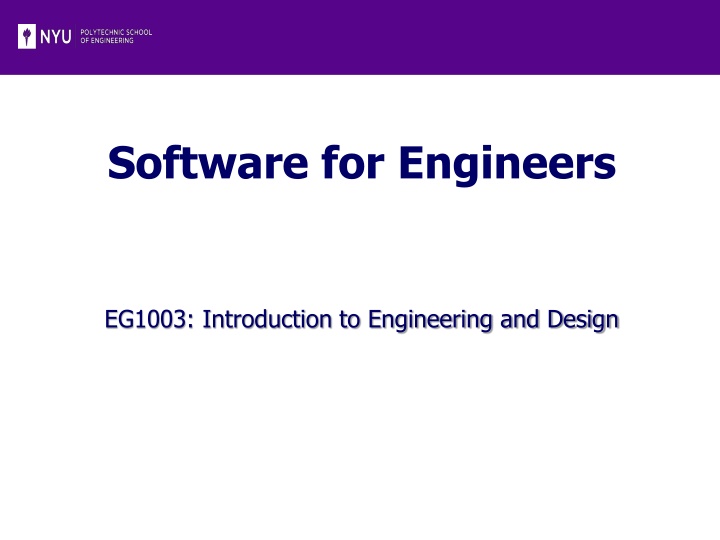
Engineering Software Tutorial: Microsoft Word and Excel Tasks
Discover how to use Microsoft Word and Excel for engineering tasks in this tutorial designed for students. Learn how to copy documents, personalize content, record data, replicate tables, create computed values, plot graphs, and more. Get hands-on experience with practical examples and step-by-step procedures.
Download Presentation

Please find below an Image/Link to download the presentation.
The content on the website is provided AS IS for your information and personal use only. It may not be sold, licensed, or shared on other websites without obtaining consent from the author. If you encounter any issues during the download, it is possible that the publisher has removed the file from their server.
You are allowed to download the files provided on this website for personal or commercial use, subject to the condition that they are used lawfully. All files are the property of their respective owners.
The content on the website is provided AS IS for your information and personal use only. It may not be sold, licensed, or shared on other websites without obtaining consent from the author.
E N D
Presentation Transcript
Software for Engineers EG1003: Introduction to Engineering and Design
Overview Objectives Materials Background Procedure Report Closing
Objectives Familiarization with relevant software Explore Microsoft software tools Word Excel
Software Tasks Microsoft Word Copy generic document Personalize copied version Record information Microsoft Excel Replicate table of values Create computed values column Plot graph based on tabulated data Embed excel into other documents
Materials Computer equipped with: MS Word MS Excel
Background Information: Microsoft Office Software Word For lab reports, proposals, documents Excel For tables, charts/graphs, data analysis
Example: MS Excel Fric. Fac. f Run # Diff. Press. (in) 0.042 0.083 0.156 0.198 0.203 0.026 Q (cfs) 0.00355 0.00502 0.00688 0.00774 0.00784 0.00281 Vel., v1 (fps) 3.55 5.02 6.88 7.74 7.84 2.81 hL (ft) 0.73 1.38 2.32 2.99 3.06 0.46 Rey. No. R (x104) 1.21 1.71 2.34 2.63 2.67 0.96 1 2 3 4 5 6 0.027 0.025 0.023 0.023 0.023 0.027 Graph of Head Loss vs. Velocity y = 2.5605Ln(x) - 2.4235 Head Loss, hL (ft) 10.00 1.00 0.10 0 2 4 6 8 10 Velocity, v1 (fps)
Procedure: MS Word Copy generic document Information includes name, address, schedule, etc. Manual has exact specifications Edit document to include your information Save original and updated files for submittal and presentation
Procedure: MS Excel Create 2 tables based on Charles Law Temperature data values are provided by TAs Using Charles Law, calculate volumes at specified temperatures Plot volume vs. temperature based on generated tables
Assignment: Written Report Independent report (one report per student) Standard lab report submission Submit online (eg.poly.edu) before midnight of day of Lab #2 One Word Document Containing: Title Page (MS Word: name, partner, lab title, etc.) Generic Schedule Personalized Schedule Mousetrap competition report Excel File: Two tables & graph
Closing Each team member must use software Submit all work electronically by 11:59pm before Lab #2 Work together with your partner TA is always available for assistance Mousetrap Car Competition Following MS Office Exercise






















